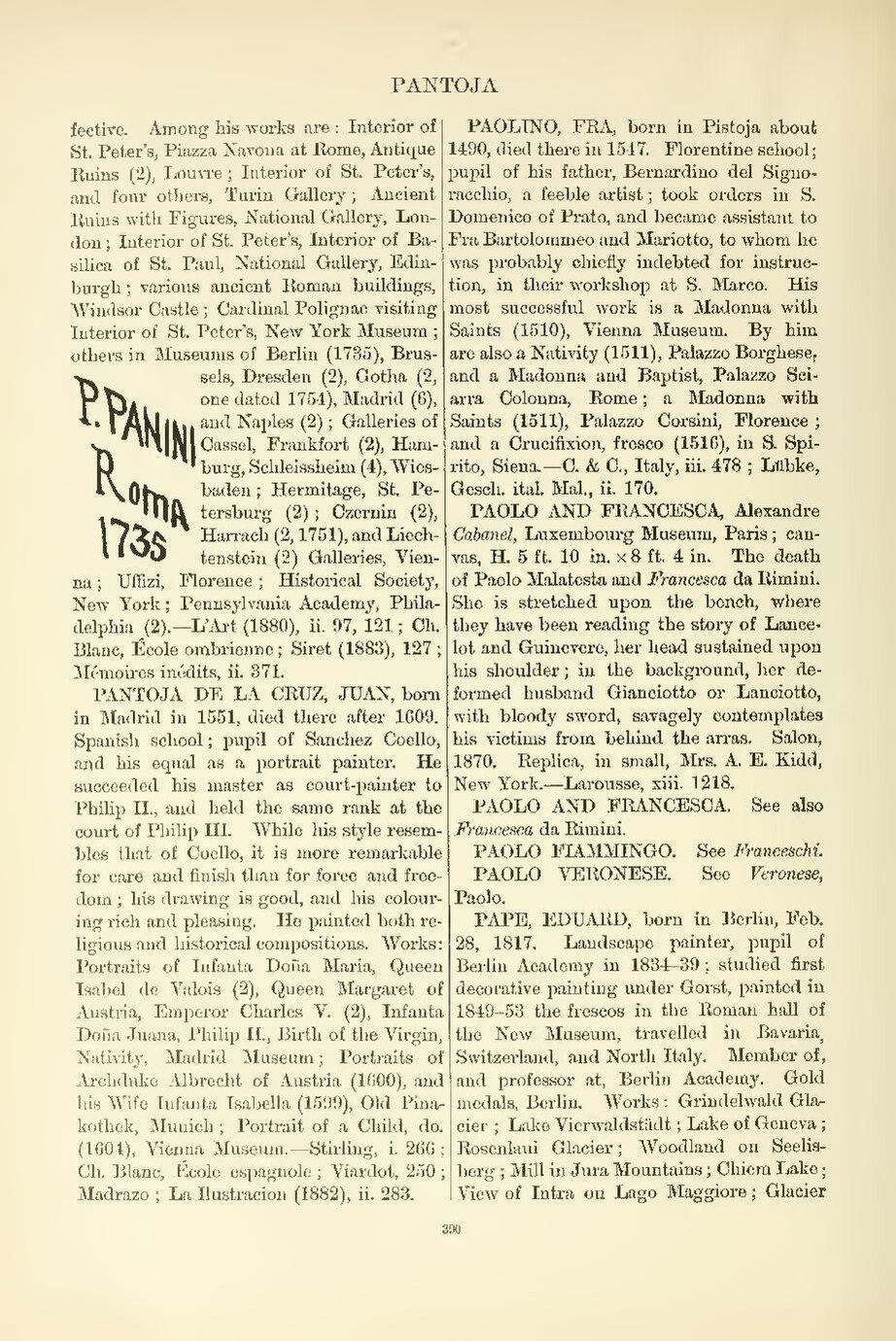- fective. Among his works are: Interior of
St. Peter's, Piazza Navona at Rome, Antique Ruins (2), Louvre; Interior of St. Peter's, and four others, Turin Gallery; Ancient Ruins with Figures, National Gallery, London; Interior of St. Peter's, Interior of Basilica of St. Paul, National Gallery, Edinburgh; various ancient Roman buildings, Windsor Castle; Cardinal Polignac visiting Interior of St. Peter's, New York Museum; others in Museums of Berlin (1735), Brussels, Dresden (2), Gotha (2, one dated 1754), Madrid (6), and Naples (2); Galleries of Cassel, Frankfort (2), Hamburg, Schleissheim (4), Wiesbaden; Hermitage, St. Petersburg (2); Czernin (2), Harrach (2, 1751), and Liechtenstein (2) Galleries, Vienna; Uffizi, Florence; Historical Society, New York; Pennsylvania Academy, Philadelphia (2).—L'Art (1880), ii. 97, 121; Ch. Blanc, École ombrienne; Siret (1883), 127; Mémoires inédits, ii. 371.
An image should appear at this position in the text. To use the entire page scan as a placeholder, edit this page and replace "{{missing image}}" with "{{raw image|Cyclopedia of painters and paintings (IA cyclopediaofpain03cham).pdf/412}}". Otherwise, if you are able to provide the image then please do so. For guidance, see Wikisource:Image guidelines and Help:Adding images. |
PANTOJA DE LA CRUZ, JUAN, born in Madrid in 1551, died there after 1609. Spanish school; pupil of Sanchez Coello, and his equal as a portrait painter. He succeeded his master as court-painter to Philip II., and held the same rank at the court of Philip III. While his style resembles that of Coello, it is more remarkable for care and finish than for force and freedom; his drawing is good, and his colouring rich and pleasing. He painted both religious and historical compositions. Works: Portraits of Infanta Doña Maria, Queen Isabel de Valois (2), Queen Margaret of Austria, Emperor Charles V. (2), Infanta Doña Juana, Philip II., Birth of the Virgin, Nativity, Madrid Museum; Portraits of Archduke Albrecht of Austria (1600), and his Wife Infanta Isabella (1599), Old Pinakothek, Munich; Portrait of a Child, do. (1604), Vienna Museum.—Stirling, i. 266; Ch. Blanc, École espagnole; Viardot, 250; Madrazo; La Ilustracion (1882), ii. 283.
PAOLINO, FRA, born in Pistoja about
1490, died there in 1547. Florentine school;
pupil of his father, Bernardino del Signoracchio,
a feeble artist; took orders in S.
Domenico of Prato, and became assistant to
Fra Bartolommeo and Mariotto, to whom he
was probably chiefly indebted for instruction,
in their workshop at S. Marco. His
most successful work is a Madonna with
Saints (1510), Vienna Museum. By him
are also a Nativity (1511), Palazzo Borghese,
and a Madonna and Baptist, Palazzo Sciarra
Colonna, Rome; a Madonna with
Saints (1511), Palazzo Corsini, Florence;
and a Crucifixion, fresco (1516), in S. Spirito,
Siena.—C. & C., Italy, iii. 478; Lübke,
Gesch. ital. Mal., ii. 170.
PAOLO AND FRANCESCA, Alexandre
Cabanel, Luxembourg Museum, Paris; canvas,
H. 5 ft. 10 in. × 8 ft. 4 in. The death
of Paolo Malatesta and Francesca da Rimini.
She is stretched upon the bench, where
they have been reading the story of Lancelot
and Guinevere, her head sustained upon
his shoulder; in the background, her deformed
husband Gianciotto or Lanciotto,
with bloody sword, savagely contemplates
his victims from behind the arras. Salon,
1870. Replica, in small, Mrs. A. E. Kidd,
New York.—Larousse, xiii. 1218.
PAOLO AND FRANCESCA. See also
Francesca da Rimini.
PAOLO FIAMMINGO. See Franceschi.
PAOLO VERONESE. See Veronese,
Paolo.
PAPE, EDUARD, born in Berlin, Feb.
28, 1817. Landscape painter, pupil of
Berlin Academy in 1834-39; studied first
decorative painting under Gorst, painted in
1849-53 the frescos in the Roman hall of
the New Museum, travelled in Bavaria,
Switzerland, and North Italy. Member of,
and professor at, Berlin Academy. Gold
medals, Berlin. Works: Grindelwald Glacier;
Lake Vierwaldstädt; Lake of Geneva;
Rosenlaui Glacier; Woodland on Seelisberg;
Mill in Jura Mountains; Chiem Lake;
View of Intra on Lago Maggiore; Glacier
